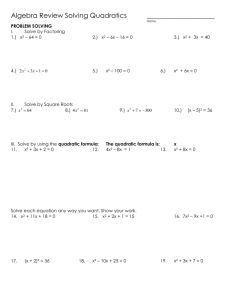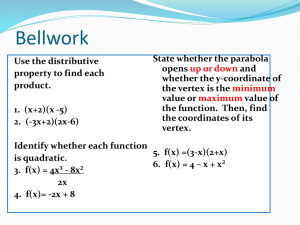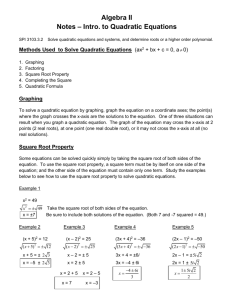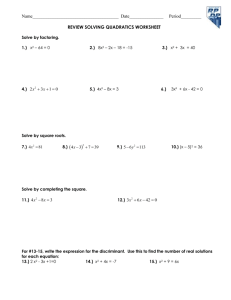File - International School of Sosua
advertisement
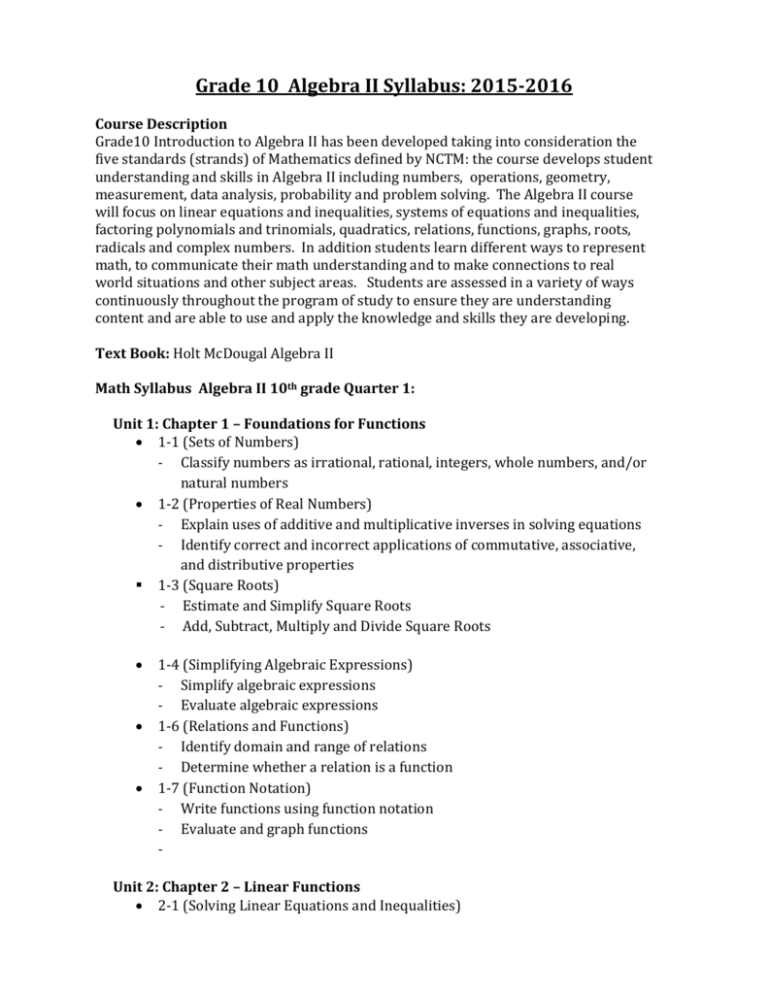
Grade 10 Algebra II Syllabus: 2015-2016 Course Description Grade10 Introduction to Algebra II has been developed taking into consideration the five standards (strands) of Mathematics defined by NCTM: the course develops student understanding and skills in Algebra II including numbers, operations, geometry, measurement, data analysis, probability and problem solving. The Algebra II course will focus on linear equations and inequalities, systems of equations and inequalities, factoring polynomials and trinomials, quadratics, relations, functions, graphs, roots, radicals and complex numbers. In addition students learn different ways to represent math, to communicate their math understanding and to make connections to real world situations and other subject areas. Students are assessed in a variety of ways continuously throughout the program of study to ensure they are understanding content and are able to use and apply the knowledge and skills they are developing. Text Book: Holt McDougal Algebra II Math Syllabus Algebra II 10th grade Quarter 1: Unit 1: Chapter 1 – Foundations for Functions 1-1 (Sets of Numbers) - Classify numbers as irrational, rational, integers, whole numbers, and/or natural numbers 1-2 (Properties of Real Numbers) - Explain uses of additive and multiplicative inverses in solving equations - Identify correct and incorrect applications of commutative, associative, and distributive properties 1-3 (Square Roots) - Estimate and Simplify Square Roots - Add, Subtract, Multiply and Divide Square Roots 1-4 (Simplifying Algebraic Expressions) - Simplify algebraic expressions - Evaluate algebraic expressions 1-6 (Relations and Functions) - Identify domain and range of relations - Determine whether a relation is a function 1-7 (Function Notation) - Write functions using function notation - Evaluate and graph functions - Unit 2: Chapter 2 – Linear Functions 2-1 (Solving Linear Equations and Inequalities) - Solve linear equations in one variable using various methods - Solve linear inequalities and compound in one variable - Graph solution sets of linear inequalities on a number line 2-2 (Proportional Reasoning) - Compute and apply unit rates - Use dimensional analysis to convert units - Solve proportions - Use proportions to solve problems with percents - Use proportions to solve real-world and geometric problems - Compute and apply percent increase and percent decrease 2-3 (Graphing Linear Functions) - Determine whether a function is linear - Graph a linear function from two points - Graph a linear function given a point and a slope - Graph a linear function from an equation 2-4 (Writing Linear Functions) - Write the equation of a linear function given its graph - Write the equation of a linear function given a point and a slope - Write the equation of a linear function given two points - Write the equation of a linear function that is parallel/perpendicular to a given line and passes through a given point - Write equations of linear functions in standard form, slope-intercept form, point-slope form, or using function notation. - Interpret the meaning of slope in a real-world context - Interpret the meaning of x- and y-intercept in a real-world context 2-5 (Linear Inequalities in Two Variables) - Graph linear inequalities on the coordinate plane - Apply linear inequalities to solve real-world problems 2-8 (Solving Absolute Value Equations and Inequalities) - Solve absolute value equations - Solve absolute value (compound) inequalities Math Syllabus Algebra II 10th Grade Quarter 2 Unit 3: Chapter 3 – Linear Systems 3-1 (Using Graphs and Tables to Solve Linear Systems) - Use tables to solve systems of two linear equations - Use graphs to solve systems of two linear equations - Determine the number of solutions to a system of two lin. equations - Use substitution to verify solutions to linear equations 3-2 (Using Algebraic Methods to Solve Linear Systems) - Solve systems of two linear equations using the substitution method - Solve systems of two linear equations using the elimination method - Write and solve linear systems of equations to solve problems 3-3 Solving Systems of Linear Inequalities - Graph systems of linear inequalities - Algebraically verify solutions to systems of equations - Write and solve systems of linear inequalities to solve real-world problems Semester Review for End of Semester Exam Math Syllabus Algebra II 10th grade Quarter 3 Unit 4 Transformations of Functions Introduction to Parent Functions: Square root and absolute value function Reflections Translations Stretches and Compressions 5-1 (Using Transformations to Graph Quadratic Functions) - Predicting transformations (horizontal and vertical shifts, stretching and shrinking, and reflection over the x-axis) of based on values of a, h, and k in Unit 5 Factoring Unit Calculating the greatest common factor of monomials Factoring out the greatest common factor from an algebraic expression Factoring the difference of squares Factoring expressions completely Solving equations by factoring Problem Solving Applications: Solving by factoring Unit 6: Chapter 5 – Quadratic Functions 5-2 (Properties of Quadratic Functions in Standard Form) - Graph quadratic functions in standard form using the vertex, axis of symmetry, and y-intercept. - Calculate the maximum or minimum of a quadratic function 5-3 (Solving Quadratic Equations by Graphing and Factoring) - Solve a quadratic equation by graphing from vertex, standard, or intercept form - Solve a quadratic equation by factoring - Write quadratic equations with given zeros 5-4 (Completing the square) - Solving quadratic equations by completing the square Solve quadratic equations using square roots Write quadratic functions in standard form by completing the square Math Syllabus Algebra II 10th grade Quarter 4 Unit 7: Complex Numbers and Quadratic Equations 5.5 (Complex Roots and Numbers) - Simplify square roots of negative numbers - Use completing the square or square roots to solve quadratic equation with complex roots 5-6 (The Quadratic Formula) - Use the discriminant to determine the number and type (real or complex) of solutions to a quadratic equation. - Use the quadratic formula to solve quadratic equations with real or complex solutions. 5-9 (Operations with Complex Numbers) - Add, subtract, multiply, and divide complex numbers - Write complex numbers in standard form - Graph complex numbers on the complex plane Unit 8: Quadratic Inequalities and Models 5-7 (Quadratic Inequalities) - Graphing Linear and quadratic inequalities - Finding Points of Intersection algebraically - Solving Quadratic Inequalities Algebraically - Problem Solving: Quadratic Inequalities 5-8 (Curve Fitting with Quadratic Models) - Write quadratic functions to model given data - Problem Solving: Applying Quadratic Models Review for end of semester exams Grading Policy: Each quarter grade is calculated according to the following percentages: Quizzes and Projects: 40% Summative Tests: 50% Homework: 10% Semester grades are developed based upon the following formula for Math: Average of two quarters: Exam Grade: 20% 80% Final grades are accrued by averaging the two semester grades.



